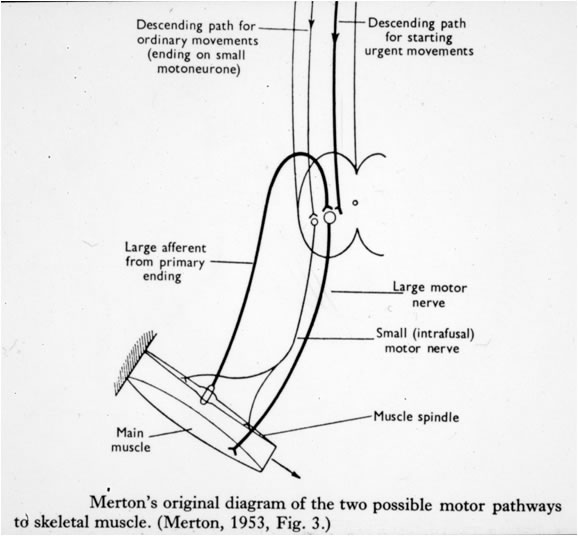Types of Intrafusal Fibres |
|
The small thin intrafusal fibres within muscle spindles are of two types. The larger diameter ones are known as 'Nuclear Bag fibres', because their central region is enlarged and containing lots of nuclei. The smaller diameter 'nuclear chain fibres' have a chain of nuclei in their central region with no overlapping of the nuclei. The annulospinal ending of the Ia sensory nerves has branches to nuclear bag and nuclear chain fibres. The Type II flower spray (secondary) nerve endings are on nuclear chain fibres. |
|
|
The information on the diagram opposite led to the following conclusions regarding the function of the muscle spindle:
These properties allow the muscle spindle to work as a length receptor over a wide range of muscle lengths
|
|
|
The alpha and gamma motoneurones are controlled by the brain as well as by segmental reflex pathways This diagram shows how descending pathways that alter the firing of gamma motoneurones (which innervate the intrafusal fibres only) can influence the sensitivity of the muscle spindle. Activation of gamma motoneurones increases the tension within the spindle and alters the sensitivity of the muscle spoindle to stretch. A consequence is that the extrafusal fibres are excited via the stretch reflex pathway, and this can contribute to tension generated within a extrafusal muscle fibres. It is known that alpha motoneuones and gamma motoenuones to a given muscle often discharge simultaneously during a voluntary contraction. This is called alpha-gamma coactivation, which means that the cortico-spinal tract (the 'direct ' pathway to alpha-motoneurones) and the reticulo-spinal tracts (to the gamma motoneurones) operate concurrently. There may also be segmental spinal cirucits (not shown in Merton's diagram) that are involved in coactivation. Spasticity. The increase in muscle tone (spasticity) seen in cerebral palsy known is a consequence of alteration in the descending control over gamma efferents. |
While Merton's original diagram suggests that the two descending pathays (cortico-spinal to alpha motoneurones, and reticulo-spinal to gamma motoneuones) operate in different circumstances, it is now known that both descending pathways work together in the control of most movements |
Gamma Efferents are of two types. Both cause contractions of intrafusal fibres. The most common type is the 'gamma-static' fibre that increases the sensitivity to stretch. In contrast the 'gamma-dynamic' fibres increase predominantly the phasic responses of the afferents. The gamma-dynamic motoneurones innervate the nuclear bag fibres, whereas gamma-static neurones innervate both types of intrafusal fibres. |
There is evidence that the gamma efferents are continuously active, and act to modulate the activity of the muscle spindle so as to force the organ to work in its optimal functional state. It is believed that both the gamma-static and gamma-dynamic efferents are active at rest and during normal movements, i.e. both are involved in alpha-gamma coactivation. |


